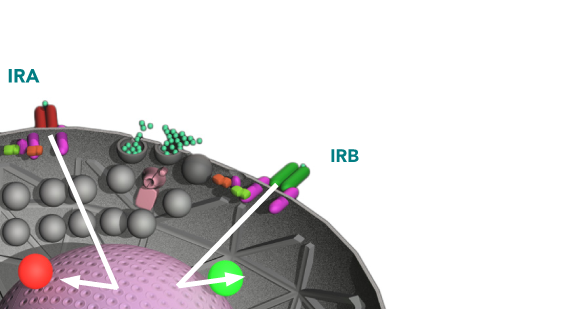Insulin receptor isoforms as targets

The screening platform allows to identify whether a substance (peptide, aptamer, etc.) positively or negatively affects insulin signalling via insulin receptor A (IR-A) or insulin receptor B (IR-B). Activation of IR-A versus IR-B can be detected by an increase in red versus green fluorescence, respectively.
.
.
.
.
.
.
.
.
.
.
Insulin sends signals to cells via two receptors
Insulin has many functions in the body and affects the activity of most cells. To initiate specific molecular processes in a cell, insulin binds to one of its two receptors, IR-A and IR-B, embedded in the cell membrane.
Signaling via IR-A and IR-B leads to distinct molecular events
In the pancreatic beta-cell for example, binding of insulin to IR-A initiates a chain of molecular events resulting in insulin production. On the other hand, binding of insulin to IR-B increases the production of glucokinase, the glucose sensor of the beta-cell.
Different tissues have different amounts of IR-A and IR-B
Almost every cell in the body has both IR-A and IR-B embedded in its plasma membrane. Typical insulin targets tissues like fat, muscle and liver cells have predominantly IR-B. Cancer cells, on the other hand, have mostly IR-A.
Platform for screening substances that selectively inhibit or activate insulin receptors
Biocrine has developed a set of tools facilitating efficient and precise screening of compounds that selectively activate or inhibit signalling via either IR-A or IR-B. In a fluorescent microscope, activation of IR-A versus IR-B can be detected by an increase in red versus green fluorescence, respectively.
.
.
.
.
Read more about insulin receptor isoforms:
- Insulin-feedback via PI3K-C2α activated PKBα/Akt1 is required for glucose-stimulated insulin secretion. Leibiger B et.al.FASEB J. 2010 Jun;24(6):1824-37
- Novel aspects on pancreatic beta-cell signal-transduction. Leibiger I et al. Biochem Biophys Res Commun. 2010 May 21;396(1):111-5
- Insulin Signaling in the Pancreatic β-Cell. Leibiger I et al. Annu Rev Nutr. 2008;28:233-51
- Selective gene activation by spatial segregation of insulin receptor B signaling. Uhles S et al. FASEB J. 2007 May;21(7):1609-21
- Isoform-specific insulin receptor signaling involves different plasma membrane domains. Uhles S, et al., J Cell Biol. 2003 Dec 22;163(6):1327-37
- Insulin feedback action on pancreatic beta-cell function. Leibiger I et al. FEBS Lett. 2002 Dec 4;532(1-2):1-6
- Selective insulin signaling through A and B insulin receptors regulates transcription of insulin and glucokinase genes in pancreatic beta cells. Leibiger B, et al., Mol Cell. 2001 Mar;7(3):559-70
- Glucose-stimulated insulin biosynthesis depends on insulin-stimulated insulin gene transcription. Leibiger B et.al. J Biol Chem. 2000 Sep 29;275(39):30153-6
- Exocytosis of insulin promotes insulin gene transcription via the insulin receptor/PI-3 kinase/p70 s6 kinase and CaM kinase pathways. Leibiger I et.al. Mol Cell. 1998 May;1(6):933-8
- Diet-induced β-cell insulin resistance results in reversible loss of functional β-cell mass. Paschen M et al. FASEB J. 2019 Jan;33(1):204-218.
- Mechanistic understanding of insulin receptor modulation: Implications for the development of anti-diabetic drugs. Yunn NO et al. Pharmacol Ther. 2018 May;185:86-98.
- Intraocular in vivo imaging of pancreatic islet cell physiology/pathology. Leibiger IB et al. Mol Metab. 2017 May 4;6(9):1002-1009.
- Non-invasive cell type selective in vivo monitoring of insulin resistance dynamics. Paschen M et al. Sci Rep. 2016 Feb 22;6:21448.
- Nephrin Contributes to Insulin Secretion and Affects Mammalian Target of Rapamycin Signaling Independently of Insulin Receptor. Villarreal R et al. J Am Soc Nephrol. 2016 Aår;27(4):1029-41.
- PI3K-C2α Knockdown Results in Rerouting of Insulin Signaling and Pancreatic Beta Cell Proliferation. Leibiger B et al. Cell Rep. 2015 Oct 6;13(1):15-22.
- Apolipoprotein CIII links islet insulin resistance to β-cell failure in diabetes. Åvall K et al. Proc Natl Acad Sci U S A. 2015 May 19;112(20):E2611-9.
- The paired basic amino acid-cleaving enzyme 4 (PACE4) is involved in the maturation of insulin receptor isoform B: an opportunity to reduce the specific insulin receptor-dependent effects of insulin-like growth factor 2 (IGF2). Kara I et al. J Biol Chem. 2015 Jan 30;290(5):2812-21.
- Ciliary dysfunction impairs beta-cell insulin secretion and promotes development of type 2 diabetes in rodents. Gerdes JM et al. Nat Commun. 2014 Nov 6;5:5308.
- Proinsulin C-peptide and insulin: Limited pattern similarities of interest in inter-peptide interactions but no C-peptide effect on insulin and IGF-1 receptor signaling. Henriksson M et al. Cell Mol Life Sci. 2006 Dec;63(24):3055-60.
- Short-term regulation of insulin gene transcription. Leibiger B et al. Biochem Soc Trans. 2002 Apr;30(2):312-7.
- Online monitoring of stimulus-induced gene expression in pancreatic beta-cells. Moede T et al. Diabetes. 2001 Feb;50 Suppl 1:S15-9.

